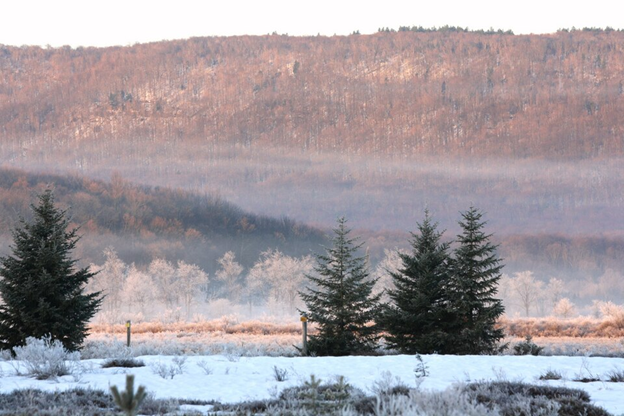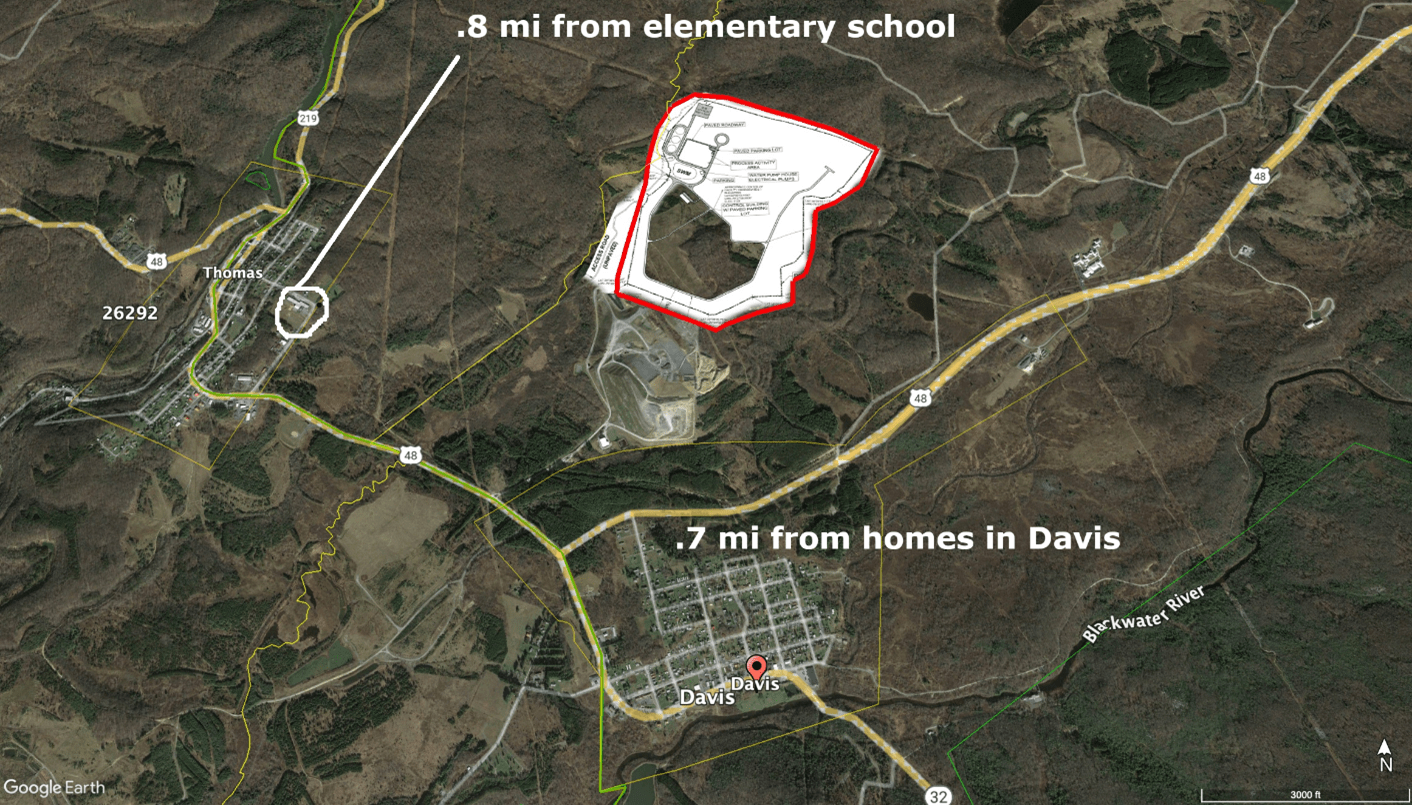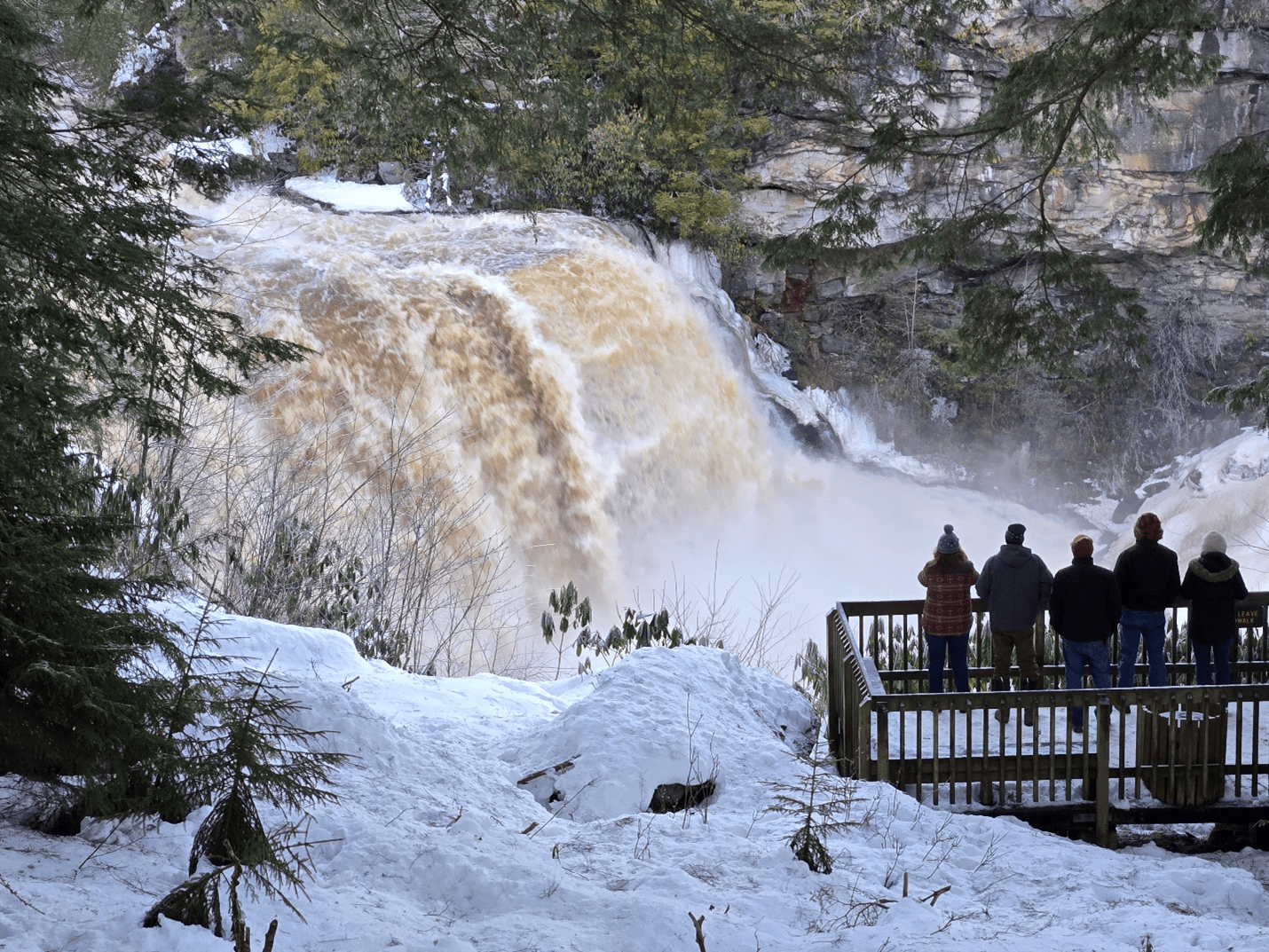Tucker County: “Yellowstone of the East” or Appalachia’s “Cancer Valley”?
by Amelia Jaycen

A beaver pond near Freeland Boardwalk Trail at Canaan Valley National Wildlife Refuge. (Frank Ceravalo, Public Domain)
In Tucker County, West Virginia, two towns with populations of about 600 each are nestled next to the largest high-elevation wetland valley east of the Mississippi. After a long history of coal mining and logging, these tiny mountain towns found a way to reinvent themselves by creating a thriving arts district and promoting the stunning local natural landscape.
Now, the area is at risk of backtracking into heavy pollution, severe health risks, and environmental damage. Threats of haphazard development, including a proposed data center complex, ignore decades of local expertise. While all development involves some risks of environmental harm and human health impacts, intentional siting and implementation can make a difference. Citizens in Tucker County have well-researched ideas about where to site projects to benefit business and minimize harm to plants, animals, and people—and they want a voice.
“It’s long frustrated me that West Virginia has the natural resources that other states only wish they had—amazing mountains, amazing scenery—and yet they seem to want to shave off all the mountains, extract the minerals, mine the landscape,” meteorologist David Carroll said, in an interview for the Steady State Herald. “And then this power plant proposal is just an insult to that entire area and the people that live there.”
A recent push to develop U.S. AI capabilities at all costs has emboldened West Virginia lawmakers. Legislation recently passed in the West Virginia House paves the way for data center development with zero input from locals. The pollution coming with it could be deadly for small communities without access to major hospitals. Situated upwind of a biodiversity hotspot, it will imperil species and unravel ecosystems already reeling from climate change.
Yellowstone of the East
Tucker County draws visitors from around the globe, and its unique wilderness features have earned it the nickname “Yellowstone of the East.” Some 8,400 acres of wetlands comprise the second-largest inland freshwater wetland complex in the United States. The county hosts flora and fauna that are globally rare, including thirteen rare vegetation communities and more than 26 rare and protected species. It has more than 2,200 acres of rare conifer swamps and red spruce forests.

A late winter sunrise at Canaan Valley National Wildlife Refuge. (Ken Sturm/USFWS, Public Domain)
Canaan Valley National Wildlife Refuge, located in Tucker County, was established in 1994 as the nation’s 500th designated wildlife refuge. It has since grown to encompass 16,628 acres. Most of Tucker County is located within Monongahela National Forest, which encompasses nearly 1 million acres managed by the U.S. Forest Service. Tucker County is a biodiversity hotspot, a designation given to areas with high “species richness” (number of species), endemic species (found nowhere else), and a large number of threatened and endangered species. As usual, these species are imperiled by human economic activity.
For example, a planned four-lane highway project would cut through the middle of the Blackwater River watershed and Monongahela National Forest. The construction would irreparably destroy habitats, imperil species, compromise wilderness values, and corrupt renowned scenery. It would also disturb old mine tunnels that would collapse and pollute the rivers with acid mine drainage.
As a result, the Blackwater River was listed on the 2024 list of “endangered rivers.” Locals have proposed an alternative, northern route that would decrease the extent of environmental damage. So far, they haven’t gotten confirmation that developers will take their expertise into account.
Locals have capitalized on the outdoor recreation industry to keep the valley community alive. Tourists from Washington, D.C., Baltimore, and northern Virginia flock to the area to experience the wildlife refuge, two state parks, and the Dolly Sods Wilderness, plus two Alpine ski resorts and one Nordic ski area. The Blackwater River is known for its first-class whitewater adventures and a spectacular 62-foot waterfall. Canaan Valley Resort State Park has 47 ski trails and a golf course, and underwent a $34 million renovation in 2013.
Winter in Tucker County is particularly popular. The annual snowfall and frosty cold of this unique West Virginia valley is almost as rare as the plant and animal species. Canaan Valley has an “average snowfall higher than any large city” in the United States, according to NOAA scientists Christoph Vogel and Bob Leffler.
The county encompasses a “frost hollow,” a topographically ideal setup for trapping cold air in the valley, resulting in extremely cold temperatures and frequent frosts almost year-round. On January 22, 2025, Canaan Valley recorded the lowest temperature in the lower 48 states (-28 degrees Fahrenheit). Vogel and Leffler note, “Canaan Valley’s ‘cash crop’ may indeed be its climate.”
Data Center Development Seems Secret by Design
Recently, Alan Tomson, mayor of the town of Davis, got a call from a concerned county citizen who ran across a filing for an air-quality permit. She asked if he knew anything about the large gas-fired power plant to be built in town. Tomson hadn’t heard of it. He called the mayor of Thomas, three miles down the road, who “was equally unaware.”
Tomson also called the president of the Tucker County Commission: “They also had no inkling anything like this was going on, that it was even a possibility.” Local leadership was completely blindsided.
“I think a responsible business considering anything like this would have reached out to the local community and started some kind of a dialogue,” Tomson said. “This is a big power plant—anywhere from 1,000 to 1,600 megawatts—with a large capacity that will not be connected to the grid, that might only be supplying data centers.”
Once locals were aware, scrutiny of the air-quality permit filed by Fundamental Data to build a large gas power plant revealed a series of concerns. Located less than a mile from an elementary school and residential areas, and upwind of the bowl-shaped Canaan Valley, the power plant’s emissions are a threat to residents and wildlife. But residents have had to deduce most of the details with painstaking citizen science, because the air-quality permit application is so heavily redacted.

A map created by a member of the citizen group Tucker United showing the proposed power plant location in relation to the towns of Thomas and Davis. (Satellite imagery from Google Earth)
Claiming confidential business information, the company removed key information needed to model how far its emissions would spread. The proposal is “the most heavily redacted document I’ve ever seen,” one resident said in a video produced by Tucker United, the citizen group locals formed to try to get answers.
Fundamental Data has barely responded to the community’s requests for information. A company representative told the Wall Street Journal it plans to build the largest data center complex in the world, up to 10,000 acres, in Tucker County. The air-quality permit application claims the power plant will be a “minor source” emitter, but the numbers don’t add up.
One long-time tourist to Tucker County, Tyler Nielson, is so enamored with the wilderness experience in this unique area, he did an analysis of 80 power plants in a nine-state area, learning the distinction between “minor” and “major” emissions. Considering its size, Fundamental Data’s power plant should be a “major source,” but companies are allowed to self-report their category with no oversight. Listing themselves as a minor source allows the company to avoid the environmental and human health impact studies required by major sources.
Residents are wise to be concerned. Researchers at Caltech and the University of California calculated that training a single AI model, for example, “can produce as much PM 2.5 [fine particulate matter] as more than 10,000 round trips by car between Los Angeles and New York City.” PM 2.5 infiltrates deeply into the human body. It’s been linked to serious health impacts, including respiratory diseases, cardiovascular conditions, and elevated cancer risk in communities near power plants.
Poor Planning and Bad Policy: A Deadly Combo for Human Health
Carolyn Culver is an expert on inflammation, cancer, and other impacts of PM 2.5 on the heart, lungs, and cells of the body. She owns two homes in Tucker County: one where she plans to retire, and one across the street for her autistic son, who will need family close by for the rest of his life.
“We’re personally very concerned, because one of our kids has inflammation of the esophagus, which is similar to asthma,” Culver said. “One of the reasons we picked Tucker County is because it is away from pollution, away from massive factories. We felt like we were in a safe place for having clean air. But the sheer proximity of this power plant so close to two towns and a school is an illogical site in my opinion. Why would you choose to put a power plant there? Proximity matters in air pollution.”
Culver has spent her career studying the specific series of events triggered by the human immune system, known as inflammation pathways, when people are exposed to air pollution.
“I have studied the exact pathway that these pollutants use in the lungs and in cancer,” Culver said. “Particulate matter 2.5 is so tiny, it’s able to penetrate into the lungs and the blood stream, and it causes systemic inflammation, which can result in pre-term birth and lung stunting in children, so it’s extremely dangerous.”
Culver has reviewed the pollutants expected from the power plant in Tucker County and documented the impacts that can be expected. The list is dizzying.

A page from the air-quality permit application Fundamental Data submitted. While the fine print is frustratingly faint, the redaction is arrogantly glaring.
According to Culver’s research, nitrogen oxides cause airway inflammation, cardiovascular strain, and instances of asthma to soar in children and the elderly. PM 2.5 penetrates the lungs and bloodstream and increases cardiorespiratory mortality. Sulfur dioxide triggers bronchial constriction and increases hospital admissions. Volatile organic compounds cause direct irritation to the eyes and respiratory tract and increase the risk of cancer and liver damage. Formaldehyde leads to increased leukemia risk. Carbon monoxide causes a higher incidence of cardiac events in seniors and damage in the nervous systems of developing fetuses.
From what Culver has seen and studied, the risks for residents living in close proximity to power plants include asthma, pulmonary disease, preterm births, leukemia, lung cancer, nervous system damage, tissue oxygen deprivation, cellular damage, developmental deficits, IQ loss, and dementia.
Multiplied Pollution
The topography of Canaan Valley would have a “multiplier effect” on the power plant’s air pollution. The same conditions that make this “frost hollow” ideal for snow sports create a weather phenomenon that traps air in the valley. This phenomenon, known as a “thermal inversion,” causes the air on the valley floor to be colder than the air above it, creating an inversion of the normal temperatures. The bowl shape of the valley floor traps air, with the warm air above it acting like a blanket that keeps still, cold air—and pollution—trapped in the valley.
“Thermal inversion has been shown to produce a multiplier effect on pollutants because they are trapped near the ground, increasing exposure and risks to public health,” Culver said. “A temperature inversion multiplies the impacts of the pollutants by two to five times. So it’s a dangerous air pollution situation that has been made extremely dangerous by the topography of this site.”
If developers move forward with the site plan as currently drawn, without consulting local experts, skiers will be slaloming straight into a cloud of trapped air pollution. Visiting this winter resort could include a dose of toxins that increase visitors’ risks of asthma, cancer, cardiovascular strain, and cellular damage.
“Yes, that is literally the case,” Tyler Nielson said. Nielson grew up in Salt Lake Valley, a much bigger valley prone to temperature inversions and air pollution. He’s had a life-long struggle with respiratory problems as a result of exposure to air pollution as a child.

With a height of 62 feet, Blackwater Falls in Tucker County is a popular tourist attraction year-round. (Amelia Jaycen)
“Canaan Valley is sort of a bathtub if you look at it on a topographic map,” he said. “It’s low and open on one end, where the Blackwater River flows in and out of Canaan Valley, with the prevailing winds coming from the west. So, in wintertime, you would be blowing whatever comes out of that power plant stack into a bathtub. If you have a trapping layer of warm air from a temperature inversion, it’s as if you were emitting that pollution into a much smaller space.”
This trapped pollution would become the new normal for Tucker County residents and visitors. According to David Carroll, a meteorologist and professor at Virginia Tech, thermal inversions occur in Canaan Valley on average every third day.
Carroll has been studying Canaan Valley since 2018. He has installed a series of sensors throughout the area, which he and colleagues hiked miles to remote areas to install. The sensors allow him to closely monitor detailed weather information, including temperature and wind speed, throughout the valley year-round. When I interviewed Carroll in July, temperature inversions had occurred in Canaan Valley every single night of the preceding week—seven days in a row.
“I don’t know if the local citizenry understands how much this would impact their day-to-day lives,” he said. “Everybody that’s downwind—every valley location downwind from that facility—will get this pollution. It’s not just Canaan. Canaan just happens to be the closest and is the one with all of the unique habitat and rare species.”
Since Tucker County residents first learned of the proposed data center in March, they have worked tirelessly to compile information about the risks and get answers from Fundamental Data. The company’s air-quality permit application received 1,623 public comments.
On August 15, the West Virginia Department of Environmental Protection (DEP) approved Fundamental Data’s air-quality permit for the Ridgeline Facility in Tucker County. The notice states that even after consideration of public input, DEP determined the proposed facility meets “all applicable state and federal air-quality rules and regulations.”
The citizen group Tucker United plans to appeal the decision and continue to fight against the unwanted development, calling DEP’s decision a failure to uphold their mission to protect air, water, and land in West Virginia.
 Amelia Jaycen is a program manager at CASSE.
Amelia Jaycen is a program manager at CASSE.





I am deeply disturbed by the proposal to place a massive data center complex and another power plant just upwind of two of the Mid-Atlantic’s most treasured natural jewels: Canaan Valley and Dolly Sods, WV. How ironic that this unique landscape, so remarkable that the federal government has twice proposed establishing a new National Park here in the past two decades, now faces the threat of becoming home to one of the world’s largest data industrial parks. How much more preposterous can it get?
West Virginia faces a choice: Preserve this region as a national recreation, scenery, and tourism center or scar the landscape, air, and water once again (like was done in the 1800’s) with 10,000 acres of industrial development and yet another power plant. These paths are fundamentally incompatible. Industrial sprawl and pollution simply cannot co-exist with pristine scenery and recreation.
As a practicing local meteorologist who provides winter forecasts for four ski resorts, Tucker County, and two of WV’s major state parks in the immediate area, I harbor expertise on the critical issue of temperature inversions and pollutants. Canaan Valley is subject to the most frequent and intense inversions in eastern North America, owing to its high elevation and enclosed basin topography, which generates and traps cold air. These inversions create conditions that lock in pollutants, exactly what such industrial development would produce.
The seriousness of this issue is underscored by the fact that the National Weather Service is publishing a paper this year on how to improve minimum temperature forecasts in Canaan, because current numerical models cannot capture the incredible strength of these inversions.
This proposal must be stopped before it gains any traction. Canaan Valley and Dolly Sods must be protected as irreplaceable treasures for future generations, not subjected to another wave of industrial exploitation like the coal and timber days of the late 1800s.
Thank you so much for covering this important issue. Tucker County is a beautiful and special place that should be celebrated for its natural wonders, not destroyed by out-of-state tech companies. It’s critical to fight not only for Tucker County, but for all the amazing places that are being threatened by massive power plants and data centers.
One look at a map and it becomes obvious that this area is unique. Immediately *downstream* from this proposed development there are three ski resorts, three Nature Conservancy preserves, two national forest wilderness areas, two state parks and one national wildlife refuge. While the “not in my backyard” argument can apply to any place and anyone’s location, it is hard to imagine a more inappropriate site for this type of development.
Tucker County would be (quite selfishly) much better served by upgrading the status of Canaan Valley to a US National Park. Pretty much instantly one would have, at a minimum, retired people with their lifetime national park pass putting Tucker County on their bucket list for visiting. Revenue to the county from park visitors would be basically inevitable, and helpful.
Data centers are actually sort of an economic dead zone. One has a couple guards at the entrance, and that’s pretty much it, for jobs. Data centers don’t even have the truck visitors that logistics centers (warehouses) get. Everything is done remotely, once built.
I urge Tucker County to be selfish, greedy for money, whatever one wants to call it .. and say NO to data centers, and YES to a nice new National Park.
The citizens of these towns in Tucker County need to arm themselves with Community Rights literature and contact CELDF. Sadly, a website that used to specialize in Community Rights and environmental protection literature closed during the COVID-19 pandemic due to being grossly outcompeted by Amazon. Ironically, Amazon, which we know as an online retailer, is also one of the largest purveyors of data center services.
I just bought a bunch of Community Rights books through a private transaction with the owner of the defunct website. Look for some of the following books:
“How Dare We? Courageous Practices to Reclaim Our Power as Citizens” by Paul Cienfuegos
“On Community Civil Disobedience in the Name of Sustainability”, produced by CELDF published by PM Press.
“Resource Manual for a Living Revolution”, by Virginia Coover et al., out of print
“We the People: Stories from the Community Rights Movement in the US”, by Thomas Linzey and Anneke Campbell
“The People’s Right of Local, Community Self-Government: Grant Township v. Pennsylvania General Energy Company”, by Thomas Linzey, Daniel E. Brannen Jr., & Elizabeth Dunne
“Organizing: A Guide for Grassroots Leaders”, by Si Kahn
“Doing Democracy: The MAP Model for Organizing Social Movements”, by Bill Moyer et al.
“Not In My Back Yard: The Handbook”, by Jane Anne Morris
“Gaveling Down the Rabble: How ‘Free Trade’ is Stealing Our Democracy”, by Jane Anne Morris
“Re: Imagining Change: How to use story-based strategy to win campaigns, build movements, and change the world”, by Patrick Reinsborough & Doyle Canning
“Defying Corporations, Defining Democracy: A Book of History & Strategy”, edited by Dean Ritz
“This is an Uprising: How Nonviolent Revolt is Shaping the Twenty-first Century”, by Mark Engler and Paul Engler
Robin,
These are great resources. Thank you for sharing these!
Thank you for this list!
Thanks, Amelia Jaycen, for covering the Tucker challenges so well. The state government and business leaders blindsiding local communities to set up the data center make them the material cause of this potential blight on this natural and recreational gem, to use fancy words from Aristotle. Yet the constant cultural commitment to economic growth as an unquestioned virtue is the efficient cause, most recently with the “push to develop US AI capabilities at all costs.” That sets up sequences of events in Tucker and all over. Then that dynamic gets sentimental support from people feeling that protecting nature is nice, but we need the increased capacity for sending data to keep the economy strong. Then “nice” get efficiently shunted aside. This article presents some cards that Tucker County still holds including talking up the appeal of recreation and likelihood of health dangers. A challenge is that those have more long-term appeal while economic growth in general and the deal for the data center beckons in the short run. Play your card, Tucker County! Add a designation for a new park, as Cole Thompson suggests, and they could make that long-thinking immediately appealing.
Here’s hoping that more Tucker County residents will join Tucker United in their challenge to this threat. Thanks, Amelia, for telling their story. It is a menace that many are facing, often in places far less magnificent or vulnerable than this incomparable locale. Five previous generations of my family called the region home, having lived and died in Tucker and in the adjacent (and equally magnificent) Pendleton, Grant, and Randolph counties. As others have noted, the area ought to be considered for National Park status, unlikely as that is in the short term.
In the meantime, many should note the basic two-pronged rationale for the ongoing data center proliferation, neither of which makes any sense: 1) the AI “revolution” and its demand for data, and 2) the wholly unnecessary crypto-currency mining industry, fueled by similar data demands.
AI investment is now recognized by more and more as a “bubble” or Ponzi scheme, especially as the “returns on investment” remain close to zero and the Large Language Models on which it is based continue to produce more “slop” than intelligence. Even insiders are starting to tamp enthusiasm for its “promise.” The Crypto industry stands on even shakier ground, since there is no rationale for its existence at all outside of hoary myths about Central Banks and currency stability. Even its promise of zero transaction costs is a fool’s errand, for it considers costs only after the crypto has been intensively mined and it ignores the way in which the regulation of financial markets can significantly reduce transaction costs, without all the misallocation and environmental degradation.
Nearly all of the marginal electricity (and related water) consumption in the developed world in the last five years or so is attributed to these two worthless enterprises. Before their emergence, rising data usage did not require more energy, thanks to ongoing microchip efficiency. As the Chinese have done with crypto, it’s time to consider bans.
Thanks, Dave. My delay in response (my bad) provides a chance to comment on still more developments. You make a good point that “nearly all of the marginal electricity (and related water) consumption in the developed world in the last five years or so is attributed to these [AI] enterprises.” And in addition, a large amount of the much, well, trumpeted increase in the stock market is based on increases in AI-related stocks. The stock market is not the economy. Look beneath those stocks and even the stock market is not as robust as the aggregate numbers indicate. And that’s even before considering the economy as a whole.
On the stock market, see Paul Solman, “K-shaped economy: Why the wealthy are thriving as most Americans fall behind,” NewsHour, October 14, 2025, https://www.pbs.org/newshour/show/k-shaped-economy-why-the-wealthy-are-thriving-as-most-americans-fall-behind, quoting Heather Long of Navy Federal Credit Union, “the stock market [is]… being hugely driven by a handful of superstar tech companies that are involved in the A.I. boom. And they’re just in a totally different league right now than everybody else.”